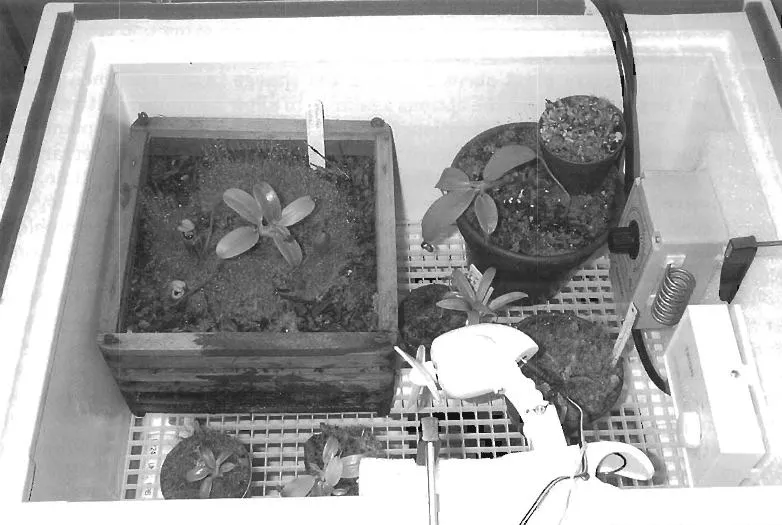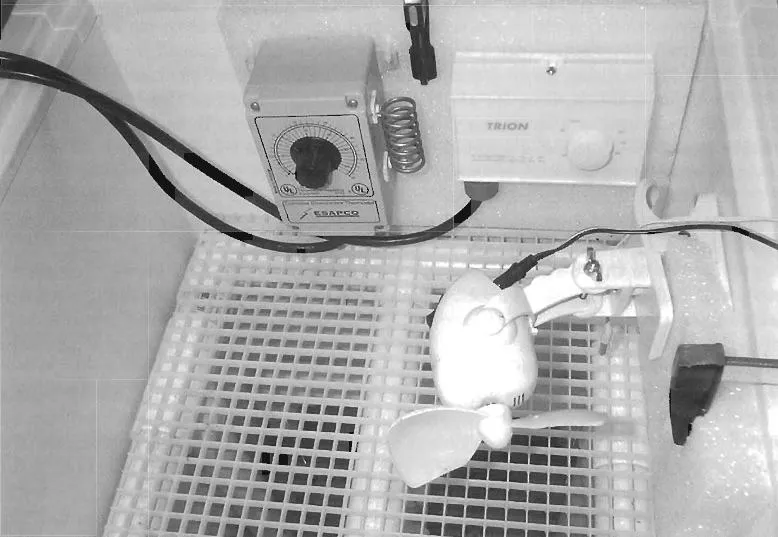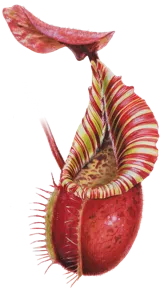This article was originally printed in the CPN, Volume 32 Number 1, in March 2003. The scanned version was not suitable for screen-readers and went offline, so I have reproduced it here with Dr. Jeff Shafer’s permission. I hope that this will enable more growers to learn from his approach to growing ultra highland Nepenthes.
⚠️ Disclaimer: The author wishes to clarify that certain methods described in the 2003 article on cultivating Nepenthes villosa involved experimental modifications of electrical equipment. These modifications can be hazardous and should not be attempted without professional supervision. The author assumes no responsibility for injury, damage, or loss resulting from attempts to replicate those methods. Safer, updated cultivation approaches are now available and recommended instead.
A Novel Method for the Cultivation of Nepenthes villosa
by Jeff Shafer, Ph.D.
Nepenthes villosa! Who among the ranks of nepenthophiles has not dreamed of successfully growing this species, the crown jewel of Mt. Kinabalu? Personally, I have coveted it since first seeing its image in the May 1964 issue of “National Geographic” magazine, many years ago. Of course, I also despaired of ever having an actual opportunity to grow it since the possibility of obtaining a specimen seemed remote indeed. However, with the advent of tissue culture techniques, it is now possible for almost anyone with the desire to grow this plant to do so. Or, at least, to try to do so!
Ah, yes, therein lies the rub, as Shakespeare would say. For, as many of us have discovered, N. villosa is truly a demanding plant to grow. Although more tolerant of warm temperatures as a seedling, its requirements are still rather stringent. In fact, for several reasons this is a species which I recommend only for the true die-hard Nepenthes aficionado.
First, this is a plant which really does need cold nights (down to 2-4°C, 36-39°F) and cool days (13-16°C, 55-61°F) to truly thrive. It is therefore not a suitable candidate for even the standard highland Nepenthes environment. Yes, it can tolerate warmer conditions, at least for short periods of time, but growth will slow to a virtual standstill, and pitchering will cease. In addition, such stress greatly increases the plant’s susceptibility to disease. Secondly, this plant likes high levels of illumination. By this, I mean that while it likes as much light as other Nepenthes which grow in similarly open areas, the trick is in ensuring that meeting the species’ need for good illumination does not result in overheating.
Finally, this is at best a slow-growing plant. Thus, while one need not worry about it outgrowing its confines in short order (oh, to have such a problem!), it is important to consider whether one has the long-term interest and stability to provide the plant with the conditions it requires for the many years it will take to for it to grow to a respectable size. It is not, for example, the kind of species which should be cultivated by youngsters who are likely to lack the requisite focus and commitment required for its continued well being, or who may leave the plant in the hands of parents as they go off to college. Therefore, beautiful and desirable though it is, it is my opinion that its cultivation is best left to those whose love of, and devotion to, the genus borders on the fanatical. However, having said all that, I do believe that it is possible to grow this species, and to do so acceptably well.
Seven years ago, I received my first specimen of N. villosa, a seedling about 1 cm (0.4 in) in diameter. I was concerned about its overnight temperature requirements, but soon found that the plant was fine as long as temperatures dropped into the nocturnal range typical for highland Nepenthes, (50°F, or 10°C). However, after the plant reached a size of about 4 cm (1.6 in), its growth slowed, and pitchering became infrequent. Fearing that I would lose it, and correctly surmising that its difficulty was due to its need for cooler conditions, I promptly moved it from its bench top location to a position on the floor of my highland Nepenthes environment. Shortly thereafter, normal growth resumed and it increased in size considerably. However, as time passed, the growth of my Nepenthes collection forced me to implement changes which reduced the intensity of the illumination available for plants on the floor of my growing area. The illumination then reaching my N. villosa was no longer sufficient for its continued growth. It stopped pitchering and ceased to be its vibrant and healthy self.
Being an attentive plant slave, I noticed the change in my specimen rather quickly and began to consider the options available to allow continued cultivation of this species. The key issue, as mentioned before, is simply keeping the plant cool enough. Therefore, I initially considered building a custom refrigerated terrarium, but after further thought I “cooled” to the idea due to the obvious expense, time, and effort involved. It seemed to me that with the panoply of refrigeration technology so readily available it should be possible to apply some extant device to the problem rather easily. And, in fact, the solution I have implemented is quite obvious and simple, although still a bit expensive.
Specifically, my approach has been to employ a chest freezer of moderate size as a large terrarium. The advantages are clear: such a device is readily available, and is well suited to cool its enclosure dramatically, if need be. Furthermore, it is well insulated, and can therefore allow one to maintain very cool growing conditions, even in a warm area. Finally, the modifications required to use such a device in this unorthodox way are very slight!
Therefore, now having a reasonable plan of action, I immediately obtained a 0.15 cubic meter (5.2 cubic foot) Frigidaire chest freezer from my local retailer. The cost of this bit of refrigeration technology is about US$150 at present; not cheap, to be sure, but not incredibly exorbitant. A used freezer may be found for much less money, but make sure that such a device is functioning prior to purchase. In addition, be sure that the inside surface of the freezer is intact and waterproof. This is very important since one will not be using the freezer in the normal way, and water will quickly build up inside. Failure to observe this precaution will likely ensure immediate disaster!
The only modification I made to the freezer was to remove its lid. This was attached with a few bolts, which were easily unscrewed. I replaced this lid with one made of clear Plexiglas, about 5 mm thick. This choice was predicated upon the facts that Plexiglas is cheap, does not pose the same safety hazard as glass, transmits visible light well, and is a reasonably good thermal insulator. To minimize transmission of heat by convection, I applied weather stripping to the edges of the Plexiglas cover. When it was finished, it was ready to be placed on top of the freezer.
The major remaining issue was to accurately regulate the temperature inside the freezer. This is accomplished by means of a simple 120V thermostat, commonly available in garden supply stores. This type of thermostat may be configured to supply power to the freezer as long as the temperature inside is above the desired set point. In my case, this is about 3°C (37°F), which is appropriate for the nocturnal temperature range N. villosa requires. Once the desired minimum is set, simply plug the freezer into the thermostat and place the thermostat in the growing area inside the freezer, making sure that it does not get wet!
Of course, there are a few other details to address before actually placing plants in the modified freezer. The most pressing of these is simply having a platform on which to rest the plants. This problem may be easily solved by construction of a small support frame tailored to the dimensions of the freezer. I constructed mine from small diameter PVC piping. I chose this material because it is cheap, easy to cut, and will not rot. The amount of time required for construction is minimal; the entire process took under an hour. Once the frame was in place, I placed a platform upon it. A good choice for this is the common “egg crate” type of light diffuser, which is commonly found at home supply stores. This material is light, impervious to water, and is easily cut to fit the desired space.


The choice of illumination is up to the reader, but I do not recommend sunlight or any other source of light which will cause excessive heating. I employ two simple fluorescent fixtures, each containing two 40W, standard, cool white bulbs. These fixtures are located about 10 cm (4 in) above the transparent lid of the enclosure, and are regulated by a timer to ensure a 14-hour photoperiod. This has proven to be more than adequate for the cultivation of N. villosa. In fact, some leaf burning has been observed, and I have somewhat reduced the intensity of the illumination because of this.
When running one’s ultra-highland environmental chamber (as I like to refer to my modified freezer), it is important to bear a few points in mind. First, one must either turn the freezer off during the day to allow temperatures within to rise to acceptable daytime highs, or readjust the thermostat set point to a higher value, appropriate for daytime growing conditions. I have found that during the warmer months, the latter course of action is required, but during the winter it is sufficient for the freezer to simply turn off; during the cooler months, temperatures inside have never risen above 15°C (59°F). Second, a considerable amount of water will build up within the freezer from watering the plants. To date, this has not proven to be a problem, but it is probably ill-advised to allow excessive amounts of water to collect there. However, the presence of some water is clearly needed to maintain appropriate humidity inside the enclosure. Moreover, the presence of such water serves as an excellent source of thermal inertia. This is important since most freezers are efficient enough to lower temperatures inside themselves by several degrees per minute! Since living things are not accustomed to such rapid climatic variations, it is unquestionably beneficial to moderate these fluctuations, and I have observed that some amount of water inside the freezer serves this function well. The additional obvious benefit is that this same thermal inertia can help ensure that daytime temperatures do not rise too rapidly, or possibly to too high a value.
One may also wish to consider installing a small fan inside one’s freezer. I have done this to facilitate air circulation and to simulate the winds which Charles Clarke has informed me are very common on Mt. Kinabalu. My fan does not run continuously, but is regulated by a small humidistat which turns it on when humidity drops below 75%. This is especially useful when the freezer begins cooling the environment at nightfall, since the cooling process causes rapid condensation of moisture from the internal atmosphere.
Finally, in the interest of monitoring conditions inside, I recommend the purchase of an indoor/outdoor thermometer. Place the outdoor sensor inside the freezer, which allows for easy monitoring of temperature inside. This way, one can check the accuracy of one’s thermostat and adjust accordingly.
As of this writing, nearly a year has transpired since I first completed the process described herein. During that time, I have observed the growth of several specimens of N. villosa in my chamber. All of them have grown and pitchered successfully, and based on my observations to date, I believe it possible to reliably grow this species to large size in such an environment. In addition, other difficult species, such as N. lamii have also grown very well under these conditions. It is, therefore, the hope of the author that this approach is useful to other growers and aids them as they cultivate the coveted jewel of Mt. Kinabalu.
Many thanks to Dr. Jeff Shafer. To explore the temperature preferences of other highland species, take a look at the Nepenthes species list, or to learn more about Dr. Shafer’s collection and growing techniques, check out my interview with Dr Jeff Shafer here.


